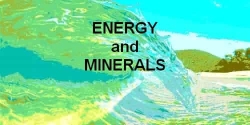Xenoliths / Xenocrysts
Xenoliths / Xenocrysts - hitchikers from the deep
source https://www.nationalgeographic.org/encyclopedia/xenolith/http://www.alexstrekeisen.it/english/vulc/xenolith.php
https://www.quora.com/How-can-I-determine-the-zircons-are-xenocrystic-zircons
http://www.nature.com/nature/journal/v448/n7156/full/448880a.html
http://www.freeexistence.org/images/meteorites/
. A xenolith is a piece of rock trapped in another type of rock. Most of the time, a xenolith is a rock embedded in magma while the magma was cooling.
Xenoliths are different types of rock embedded in igneous rock. Xenoliths are torn from deep cracks, or pipes, in the Earths surface. Magma rises to the Earths surface through these pipes between the Earths crust and mantle.
As the molten material rises, it tears off bits and pieces of the magma pipe in which it is traveling. These bits and pieces, trapped in the magma but not melting into it, become xenoliths.
Xenoliths are very useful in geology...
- they consist bits of unexposed rock often brought from great depths very useful in working out geology
- must be by defintion older than the rocks in which they are found
- they may carry evidence of the magmatic / temperature / chemical conditions beneath the earth
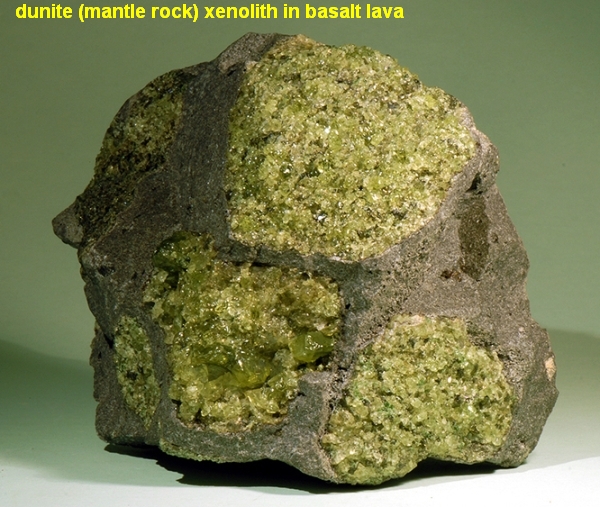
As magma erupts or flows from the Earths surface, it is cooled by exposure to air or water. Lava cools fairly quickly, and various types of igneous rocks are formed.
Xenoliths are usually visible. They have a different color and density than the surrounding igneous rock. Xenoliths can be as small as a grain of sand or as large as a football, and as long as several meters. Xenoliths and xenocrysts are affected by temperature. A xenolith may lose its unique qualities if it melts into the surrounding magma. As it cools, the material may cease being a xenolith at all and become a metamorphic rock. Xenoliths and xenocrysts are often identified by the names of the two rock types involved.
A peridotite xenolith in a basaltic lava flow, for instance, means a chunk of the rock peridotite is embedded in basalt rock. The peridotite is usually yellow and dense, while the basalt is usually grey and light.
Xenoliths and xenocrysts provide valuable information about the geology of the Earths mantle. Scientists study the chemical properties of xenoliths to understand the depth at which they were formed.
Many xenocrysts were created hundreds of kilometers within the Earth, far below the deepest mines and wells. The information about the condition of the mantle at these depths would be impossible to understand without xenoliths and xenocrysts.
Some of the features studied by geologists are temperature, pressure, construction, and movement within the Earth's surface. Xenoliths can be a piece of rock trapped in a piece of sedimentary rock, but this is rare.

Xenoliths have also been found in meteorites, or rocks from outer space that have crashed into Earth.
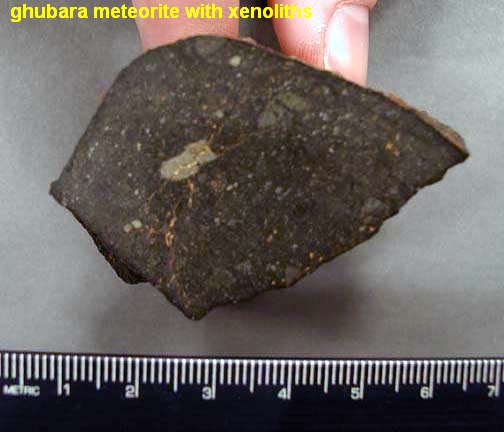
The xenoliths in meteorites were formed from collisions with other objects outside the Earths atmosphere.
This meteorite fell in the Jiddat al Harasis region of Oman (near Ghubara) in 1954. Since then, over 100 kg of specimens have been recovered. Ghubara is an olivene-hypersthene-chondrite black xenolithic L5.
Ghubara contains quite a bit of metal; it is 21.33% iron. The larger silvery spots are metals. The smaller, whitish areas are xenoliths.
These are actually fragments of another chondritic body (stony meteorite) which has been incorporated into Ghubara, probably from an impact in space.
These xenoliths are unrelated to the matrix material, and appear to be of a lower petrologic grade (the matrix is L5, but the xenoliths are L3).
see also... Meteorite Minerals... Meteorites... Identify Meteorites..
Xenocrysts
Crystals that are torn from the sides of magma pipes are called xenocrysts. Diamonds are formed in the Earth's upper mantle. A type of igneous rock called kimberlite is known for carrying xenocrysts of diamonds to the surface, where they can be mined.
Xenocrysts are very useful in geology...
- they can provide evidence of pre-existing rocks now worn away, perhaps re-cycled a number of times
- they can be used for very ancient age dating
- they provide clues to magmatic/ temperature / chemical processes deep within the crust
- some xenocrysts are valuable gemstones
- they give clues to conditions present on the crust/ mantle boundary
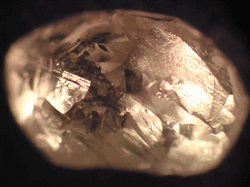
Xenocrysts are "foreign" minerals incorporated into the magma during magma scent or during xenoliths fragmentation.
There are three principal types:
- Restite material, the refractory residue brought up from the site of mantle ore crustal melting.
- Totally exotic material, ripped off the walls of conduits or the walls or roof of a magma chamber.
- Cognate material, representing perhaps an accumulation of crystals already formed in a magma chamber, later ripped up during fresh magma movement.
Xenolith that are not in equilibrium with the magma may melt, dissolve or react, and these processes may lead to their eventual assimilation. Therefore the absence of xenolith does not necessarily indicate that no contamination of magma occurred. It may in fact mean that numerous xenoliths were totally assimilated. On the other hand, the presence of numerous xenoliths does not necessarily imply the magma has been severely contaminated. They may have been incorporated without much reaction just before magma solidification. Xenoliths can be assimilated in three ways:
- Melting: Take for example a quartz-feldspar sandstone incorporated in an intermediate magma at 800°C and with a water pressure of 2Kbar; quartz, plagioclase and Orthose individually melt at temperature in excess of 800°C, but minimum-melting-point mixtures of quartz with either one or both feldspar, or feldspar with feldspar all form at temperature <800°C. this means that melting could occur everywhere quartz and feldspar or two feldspar are in contact (see image below... ) The important point to note is that melting occurs through the entire xenolith at appropriate sites (in contrast solution can occur at the margins of a xenolith). Evidence of melting is sometime preserved as a film of glass along grain boundaries, and if reaction take place in association with the melting , a spongy (Sieve) texture also develops along xenolith margins.
- Solution: Solution differs from melting in that it takes place only where the xenolith contacts magma (at its margins). The process will not in itself lead to a disaggregation of a xenolith. Xenocrysts wich undergo such solution become rounded just like some phenocrysts during magma mixing.
- Reaction: Like solution, sometime take place only where xenolith contacts magma. For example, the reaction of quartz with basic magma produces pyroxenes, usually as a fine-grained aggregate encrusting the margins of xenolith or xenocrysts. Depending on foreign material and magma composition and temperature and available time, the foreign material chemically equilibrates with the melt to varying degree. The thermal and chemical principles of assimilation were enounced by bowen (1928) many decades ago.
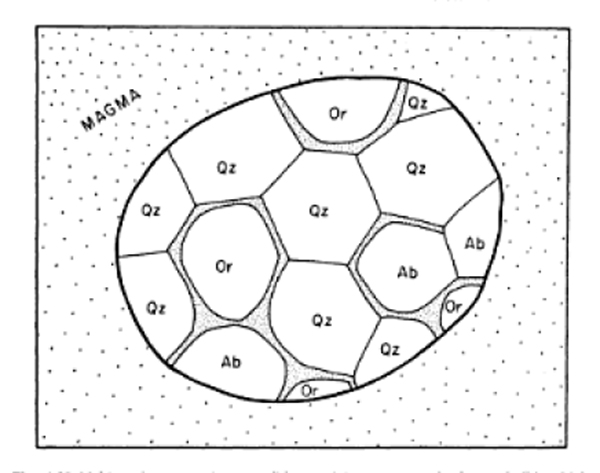
Melting Phenomena in a Xenolith containing Quartz (Qz) and Albite (Ab). Melt along grain boundaries is stippled. From Shelley
Assimilation require thermal energy, the source of which can only be the magma itself. Heat from the magma has two sources:
- That released during cooling to lower T
- The latent heat of crystallization
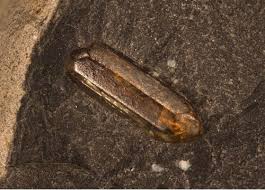
Thus, quartz xenocrysts can dissolve on a time scale of day in basaltic melts in which the activity of silica in < 1, the basalt become so enriched in silica. The presence of xenocrysts or xenoliths in a magmatic rock may suggest they are contaminants, but xenocrysts can also originate by mixing of dissimilar magmas, and foreign material can be incorporated late into the magma with minimal contamination. Some basaltic magmas are extruded on the Earth’s surface carrying pieces of the mantle, called mantle xenoliths. These xenoliths make it possible to estimate how rapidly these magmas ascended from depth to the surface, because the upward flow of magma must exceed the settling velocity of the xenoliths.

Two magma types, alkali basalt and kimberlite, commonly carry such mantle xenoliths. Both originate by small degrees of partial melting in the upper mantle near the base of the lithosphere. The common occurrence of dense mantle xenoliths in tephra and lava flow eruptions of alkali basalt indicates that this magma carried them from depth. An average settling rate for xenoliths of different sizes can be calculated by balancing the different forces on the xenoliths during ascent, and by making certain assumptions about the rheologic properties of the magma. Calculation indicates that a 20-cm-wide xenolith will settle at a rate of 0.1 m/s. Obviously, the magma ascent rate would have to be greater in order to carry the xenolith to the surface; the xenolith settling velocity gives a minimum estimate of magma ascent rate.

Core of this zircon is older at approx 4.1 billion years so it is a zenocryst
Is it a xenocryst?
Check for zonation. If the the zircons are xenocrysts then they likely will have a rim formed from the melt in which they were found, but the age on the rim will be different to the age on the core. Use Cathodoluminescence to determine zonation within each crystal, and then date the zones within the crystal. If it is xenocrystic, the age at the core will be older than the age of the rim - but remember margins of error and potential issues with crustal recycling. This is the method was used for dating the Jack Hills zircon, the oldest known material on Earth

The 4.39 billion year old zircon xenocrysts of the Jack Hills in Mid West Western Australia.
They are best known as the source of the oldest material of terrestrial origin found to date: zircons that formed around 4.39 billion years ago. These zircons have enabled ground-breaking research into the conditions on earth in the Hadean eon. In 2015, "remains of biotic life" were found in 4.1 billion-year-old rocks in the Jack Hills of Western Australia.According to one of the researchers, "If life arose relatively quickly on Earth ... then it could be common in the universe."
Was the early Earth a blackened landscape of congealed lava, or was it cool enough for oceans to form? The discovery of diamonds in the oldest-known relics of surface rocks adds new élan to this debate.

Xenocrysts give clues to the earth's earliest history...
The earliest era of Earth's history — between the creation of the planet about 4.5 billion years ago and the formation of the oldest known rocks 500 million years later — is the geological equivalent of the Dark Ages. The formal name given to the period, the Hadean, matches the long-held view that during this time Earth's entire surface, or at least large tracts of it, was a hellish, seething mass of molten lava. In contrast to that picture, recent studies of the oldest known relics of surface rocks, tiny and rare crystals of the trace mineral zircon (ZrSiO4), indicate that it took less than 200 million years for Earth's surface to cool sufficiently for water to condense.
Menneken and colleagues' discovery that some of those ancient zircon crystals contain tiny diamonds turns the field on its head once more. The results lend succour to the view that the initial hot phase was long-lived, and will invigorate questioning of the cool-Earth concept. As Earth grew in the dust cloud around the proto-Sun, probably colliding with a planet the size of Mars during the process, surface temperatures would have reached in excess of 6,000 °C. When the surface eventually cooled, solid rocks started to form, but what those rocks were like, and when the formation process started, are controversial questions. The problem is one of preservation. Intense meteorite bombardment destroyed much of the early crustal rock, and with it evidence of Earth's early environment. In addition, Earth is an active planet on which crustal rocks are continuously destroyed by weathering and erosion, and recycled deep into the interior through plate tectonics. These processes have been going on for at least 3.8 billion years, and so very few crustal rocks older than 3.7 billion years — and none older than 4.03 billion years — are known.
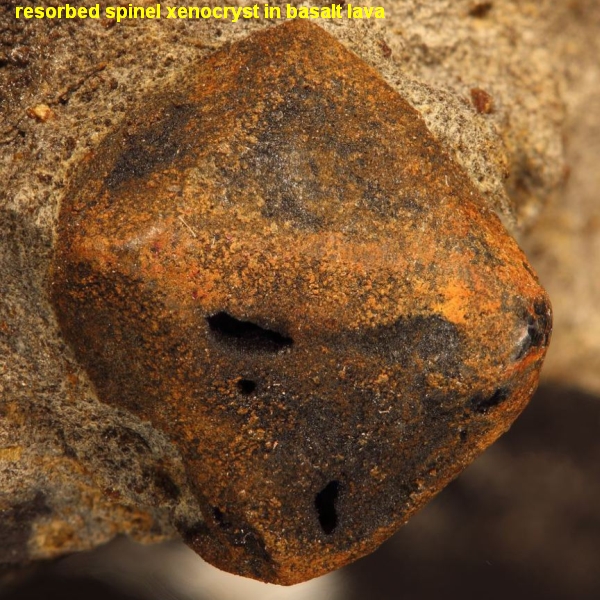
The only surviving relics of Earth's crust from those first 500 million years of the planet's history are zircon crystals, mostly recovered from slightly less ancient sedimentary rocks
Zircon is a tough mineral: it is both chemically and physically inert under a wide range of geological conditions. As a result, zircon grains formed in old igneous and metamorphic rocks are commonly recycled unchanged into younger rocks. Hadean zircon grains are small (less than 0.3 mm in diameter) and rare: so far only two rocks, both from Western Australia, have been found with an 'abundance' of the grains (which means about 1 part per million by weight).
Fortunately for those studying the early Earth, these tiny grains carry a remarkable amount of information about the rocks in which they crystallized. That information can be extracted through a range of modern techniques that allow growth zones in individual zircon grains to be analysed on a scale of a few micrometres. For example, uranium, thorium and lead isotopes provide an accurate measure of a grain's age; zoning textures and patterns of rare-earth elements5 distinguish igneous from metamorphic growth; and microinclusions of other minerals show the mineralogy of the original host rock.
The more titanium a zircon grain contains, the higher its crystallization temperature was; and the greater the grain's enrichment in the oxygen isotope 18O, the more the magma from which the zircon crystallized interacted with liquid surface water. The hafnium isotopic ratio 176Hf/177Hf indicates whether that magma was purely mantle-derived (high initial value) or contained a crustal component (low initial value).
Finally, xenon isotopes, among them the fission products of the extinct plutonium isotope 244Pu, provide some of the most direct evidence available that Earth formed with a plutonium–uranium ratio similar to that of the Sun.
Some of the conclusions reached on this basis have been challenged, principally on the grounds that some of the compositions measured do not accurately reflect the temperature or the primary chemical and isotopic compositions of the magmas from which the zircons crystallized. But a majority view prevails.
Hadean zircons are mostly of igneous origin, and crystallized in a series of events that occurred mainly between 4.25 and 4.00 billion years ago; crystallization temperatures averaged only about 680 °C ; the host magmas had compositions similar to granites, and were produced by the melting of mixtures of crustal and mantle rocks; and the crustal rocks had interacted with liquid water at or near Earth's surface.
All in all, this is convincing evidence that there were at least some periods during Earth's early history when its surface was cool. The discovery by Menneken et al. of microdiamond inclusions in about 1 in 20 zircons, ranging in age from 4.3 to 3.1 billion years, that were randomly selected from the original Jack Hills conglomerate site in Western Australia, will necessitate a careful reassessment of these conclusions.
Diamond is a mineral that forms only at high pressures, whether these are transient (during, for example, a meteorite impact) or sustained (through deep burial, for instance). It is therefore not found in low-temperature granite magmas such as those in which the Hadean zircons are inferred to have crystallised.
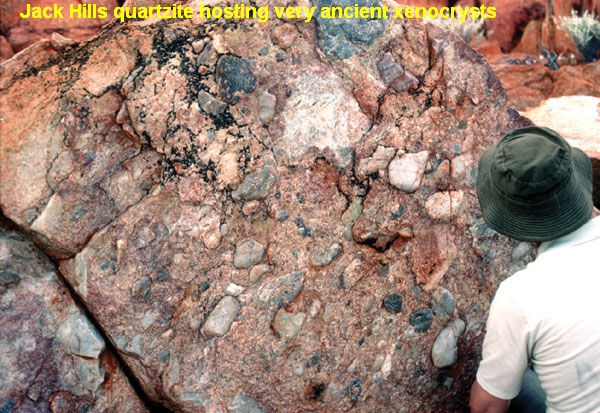
Assuming that the zircon did crystallize at temperatures of about 680 °C, pressures exceeding 3.5 gigapascals would have been needed for diamond to be stable in the magma source. This pressure is equivalent to burial more than 100 kilometres below Earth's surface. But the
Jack Hills zircons show no other evidence of such high pressures — whether transient in the form of shock features, or sustained in the form of relics of other high-pressure minerals, metamorphic overgrowths or rare-earth element compositions indicative of high-pressure growth. If the evidence of the diamonds is correct and the Hadean zircons did crystallize from magmas at high pressure, then those magmas could not have been crustal melts. This would undermine other inferences based on the assumption that the zircons preserve their original chemical and isotopic compositions — including the deduction that the early Earth was cool. Menneken et al. present two possible explanations for the presence of diamonds in zircons of such a wide age range.
Either the diamonds formed during a single high-pressure event about 4.3 billion years ago and were then recycled into younger rocks, or they were incorporated into the Hadean zircons by an undefined process that was repeated several times during the first billion or so years of Earth's history.
Neither of these explanations is entirely convincing, and the implications for surface temperatures on the early Earth are not discussed. A possible explanation that does not contradict the evidence for a cool early Earth is that the diamond was introduced to the zircon not as diamond, but as graphite precipitated into fractures and other imperfections in the zircon grains. De Corte et al, for example, have studied microdiamond inclusions in zircon from rocks subjected to ultra-high pressure in the Kokchetav Massif in northern Kazakhstan. They concluded that the original carbon that the diamonds were formed from was precipitated through the reaction of carbon dioxide with a reduced carbon phase such as methane.
One can conceive of a process in which a segment of early crust containing zircon from low-pressure igneous rocks of different ages became impregnated with carbon-rich fluids, possibly produced by reactions involving an atmosphere enriched in carbon monoxide, carbon dioxide and methane. Rapid deep burial of those rocks by subduction (horizontal tectonics), sagduction (vertical tectonics) or mantle overturn could then have formed diamond in zircon of various ages during a single event, possibly without changing the zircons' chemical and isotopic compositions. During subsequent uplift, metastable diamond trapped in zircon grains could have been preserved, with some partly reverting to graphite — as indeed is observed.
Whether the diamond was indeed produced by such a relatively rapid process, or was of long-lived mantle origin, could be tested by examining its carbon isotopic composition and whether nitrogen is present as single nitrogen atoms (indicating little time spent in the mantle at relatively low temperatures) or nitrogen pairs and tetrahedra (long residence time at relatively high temperatures). Such tests will be needed to further the lively debate on whether the early Earth was hot, or not.

